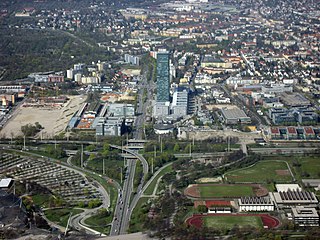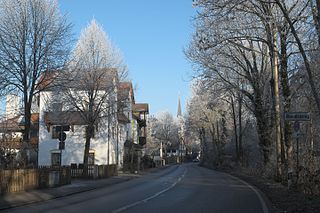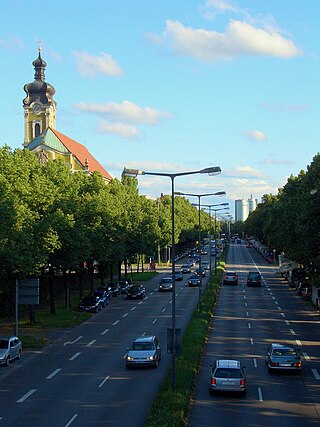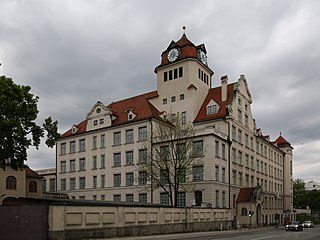
The Freihamer Allee is an avenue in the Munich district of Aubing, in the area of the Freiham estate, which was probably created in the 17th century.

The Freihamer Allee is an avenue in the Munich district of Aubing, in the area of the Freiham estate, which was probably created in the 17th century.
The Freihamer Allee starts at the Bodenseestraße (Bundesstraße 2) and goes under the railway line Munich-Herrsching, before passing through the Freiham estate. Directly south of the railway line, the Wattplatz branches off to the west, which leads to the station Munich-Freiham. South of the Freiham estate, Centa-Hafenbrädl-Straße connects to the Freiham development area and flows from the east into the avenue. Then the Freihamer Allee runs south and is designed as an avenue. It continues in the direction of Gräfelfing and is interrupted by the Bundesautobahn 96 (Munich-Lindau), which is slightly offset to the east and crossed by a pedestrian bridge. At the city boundary to Gräfelfing, in the Gräfelfinger wood meadows, it turns into the Freihamer Straße.
Until 2013, it crossed the Munich-Herrsching railway line via a level crossing that was controlled from the München-Freiham station. In September 2013, the railroad crossing was closed and replaced in 2015 by a pedestrian and bicycle underpass. [1]


U5 is a line on the Berlin U-Bahn. It runs from Hauptbahnhof in Mitte eastwards through Alexanderplatz, Friedrichshain, Lichtenberg and Friedrichsfelde, surfaces in Biesdorf-Süd to pass Kaulsdorf and Hellersdorf above ground and finally reaches city limits at Hönow.

The Munich U-Bahn is an electric rail rapid transit network in Munich, Germany. The system began operation in 1972, and is operated by the municipally owned Münchner Verkehrsgesellschaft. The network is integrated into the Münchner Verkehrs- und Tarifverbund and interconnected with the Munich S-Bahn. The U-Bahn currently comprises eight lines, serving 96 stations, and encompassing 103.1 kilometres (64.1 mi) of routes.

The Oberbaum Bridge is a double-deck bridge crossing Berlin, Germany's River Spree, considered one of the city's landmarks. It links Friedrichshain and Kreuzberg, former boroughs that were divided by the Berlin Wall, and has become an important symbol of Berlin's unity.

Munich-Pasing is a railway station in the west of Munich. It is the third-largest station in the city, after München Hauptbahnhof and München Ost.

The Ringbahn is a 37.5 km (23.3 mi) long circle route around Berlin's inner city area, on the Berlin S-Bahn network. Its course is made up of a pair of tracks used by S-Bahn trains and another parallel pair of tracks used by various regional, long distance and freight trains. The S-Bahn lines S41 and S42 provide a closed-loop continuous service without termini. Lines S45, S46 and S47 use a section of the southern and western ring, while lines S8 and S85 use sections of the eastern ring. The combined number of passengers is about 400,000 passengers a day. Due to its distinctive shape, the line is often referred to as the Hundekopf.

The Berlin Customs Wall was a ring wall around the historic city of Berlin, between 1737 and 1860; the wall itself had no defence function but was used to facilitate the levying of taxes on the import and export of goods (tariffs), which was the primary income of many cities at the time.

The A line is the north-to-south main line of the Frankfurt U-Bahn. It is the oldest and longest line of the U-Bahn system. Served by four routes starting at Südbahnhof Railway Station in Sachsenhausen, the A line runs through downtown Frankfurt up to Heddernheim Station in the north of the city, where it branches out to Ginnheim, Oberursel (U3), Riedberg and Bad Homburg (U2). The U9 service between Ginnheim, Riedberg and Nieder-Eschbach does not use the central section and tunnels of the line, making it the only light rail service of the network that does not serve downtown Frankfurt. The Riedberg and Ginnheim branches were planned as parts of the future D line subway but are operationally part of the A line until the D line development and construction is finished.

The C Line is the third line of the Frankfurt U-Bahn. It opened on 11 October 1986 and runs east-west through the city centre via Hauptwache and Konstablerwache. In the East it has branches to Frankfurt Ost railway station and Enkheim. To the North-west of the city centre it runs under Bockenheimer Landstraße before splitting into two branches to Hausen and Praunheim. The main services on the line are the U6 and U7 (Praunheim-Enkheim). Part of the branch to Enkheim also carries U4 services.

Moosach is the 10th northwestern district of Munich, Bavaria, Germany. It is sectioned in the urban districts Hartmannshofen, Pressestadt and Borstei.

The Munich–Herrsching railway is a branch line from Munich-Pasing to Herrsching in the German state of Bavaria. It is operated by DB Netz AG and is integrated into the Munich S-Bahn as part of line S8. The railway line is duplicated from Munich-Pasing to Weßling and electrified over its entire length.

Line S8 is a line on the Munich S-Bahn network. It is operated by DB Regio Bayern. It runs from Herrsching via Weßling, Pasing, central Munich and Munich East to Munich Airport station.

Am Riesenfeld is the westernmost of the three subdistricts of the Munich city district 11 Milbertshofen-Am Hart.

The Pippinger Straße is a street in the Munich districts of Pasing and Obermenzing, which for centuries runs as the Würmtalstraße on the left bank of the Würm river. The roads full-length runs through rural area, partially with fields on the western side, and undeveloped areas, although the road serves as a main connection to the Bundesautobahn 8.
The Leipzig-Plagwitz–Leipzig Miltitzer Allee railway is a two-track electrified main-line in the German state of Saxony. It runs from Leipzig-Plagwitz to Leipzig-Grünau and is integrated into the network of the S-Bahn Mitteldeutschland. However, there were no services on the line from the end of April 2011 until 14 December 2013 due to a reduction in funding for public transport.

The Donnersbergerstraße is a street in the Munich district Neuhausen, in the city district of Neuhausen-Nymphenburg. It connects the Rotkreuzplatz with the Arnulfstraße in the north-south direction. It is named after the Privy Councilor and Supreme Chancellor of the Bavarian elector Maximilian I, Joachim Freiherr von Donnersberg (1561–1650), who came from the Munich patrician family, Donnersberger.
Alte Allee is an avenue in the Munich districts of Pasing and Obermenzing, which was built around 1897.

Englschalking is a quarter of the Bavarian capital Munich and belongs to the district 13 Bogenhausen.

The Landshuter Allee is an avenue in Munich and through most of its course it is part of the Mittlerer Ring, the Bundesstraße 2 R. It joins Donnersbergerbrücke at Arnulfstraße in the Neuhausen district and runs from Dachauer Straße west of the Olympiapark to Moosacher Straße west of the Olympic village in the Moosach district. The B 2R leaves the intersection-free avenue at the Landshuter Allee and continues on the Georg-Brauchle-Ring. The Landshuter Allee now functions as the B 304 and connects the Mittlerer Ring with the northern tangent of the Outer Ring, which is only partially complete. The large width of the Landshuter Allee of 54 metres between the houses is striking. It crosses the Nymphenburg-Biedersteiner Kanal.

Boschetsrieder Straße is an inner city street in the Munich districts of Thalkirchen, Obersendling and Forstenried/Am Waldfriedhof, which runs west from Bundesstraße 11 on the Isar hillside to Kreuzhof, where it continues as the Fürstenrieder Straße.

The Munich-Neuaubing repair plants was a railroad repair works in the west of the Bavarian Bavarian capital Munich in today's Aubing district.